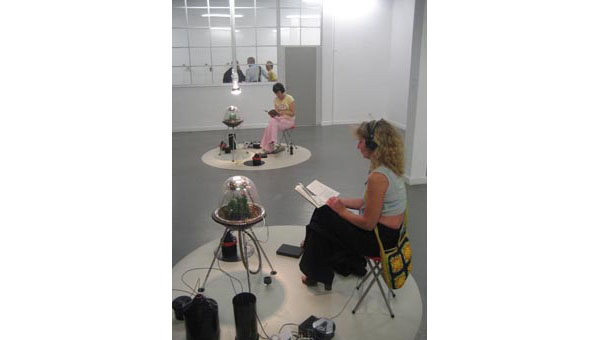“The Bureau of Found Appropriations / Département des Sourires” is a work which is part of a long-term study on strategies of appropriation and forms of production (and reproduction) in Asia. My main attention is directed towards differences, misinterpretation and errors committed in the process of translating and copying cultural commodities. How can an image be read, used, interpreted, unterstood without knowing its cultural context?
In 2008 I stayed with Matthias Meinharter for three months in southern China working on the art/film project Chinese Whispers in Dafen – the copy capital of art. There, approximately up to 10,000 painters live, work and are specialized in copying work in specific styles by a wide range of masters of historical and contemporary oil-painting. Annually, more than five million paintings are produced at assembly lines, usually copies of masterpieces.
The reason why this use of imitations strikes western societies as a serious cultural difference has to do with a strong historical correlation between painting and calligraphy: in China a good copy is often considered as a reward and honour to the technical and compositional skills of the initial inventor and master. Memorization is taught as the manually repeated imitation of an original; hence gaining knowledge is based on a culture of transcription. Therefore the terms of originality and authorship are culturally coded. By regarding these gaps with their potential shifts of meaning as a source of inspiration I started compiling a growing collection of images reflecting on cultural practices, identities and authenticities.
Concept & photos: Nikolaus Gansterer
Materials: Found images and paintings, reproduced as a limited edition of postcards
Venue: Vooruit, Ghent. Curated by Eva de Groote.
Year: Since 2008
The work is a form of re-installation according to experiments conducted mainly in the 60ties and 70ties to examine the influence of music on the growth of plants. In an intricate test arrangemnet the experiment is started to raise an ‘evil’ and a ‘good’ plant only by sonic irrigation. Two identical model organism (Arabidopsis thaliana) are confroted with a cantata by Johann Sebsatian Bach and a song by the death metal band the Peversists.
The mouse ear cress (Arabidopsis thaliana) is a small flowering plant that – due to fact that its genetic sequence is completely deciphered – is world widely used in life science. By listening to the sound piece the visitors become part of the experiment and part of complex relational system on the edge of art, life science and cultural studies. Large wall maps display crosslinks between the evolution theories and the cultural development of heavy metall music.
The visitors are invited to directly experience the experiment by entering the set up and listening to the acoustic process. The ‘Eden Experiment’ confronts us with a dubious complex system of scientific theories about the influences of sound on living organism and ironically addresses issues of genetic manipulation and reproductive technologies by questioning the imaginary threshold between nature and culture, religion, art and civilization.
Watch video of the performance lecture: Harvesting the Tree of Knowledge (12:00), 2008
Year: Since 2007
Material: Arabidopsis thaliana, wall maps, sound piece (death metal, classic music), lighting and irrigation system, timer, fertilizer,…
Dimensions: ca. 600 x 400 cm







